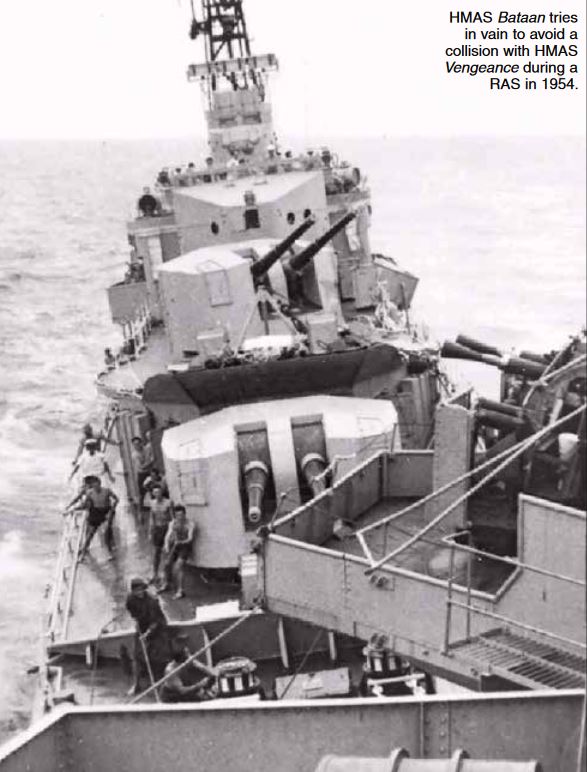A voyage from Fremantle to Cocos Islands to farewell the Royal Yacht SS Gothic at the successful end of Queen Elizabeth II’s first visit to Australia ended badly when two of the escort ships collided during a RAS. On 5 April 1954 after HMA Ships Vengeance, Anzac I and Bataan, an Australian-built Tribal-class destroyer, handed over the escort duties to the cruisers HM Ships Colombo and Newfoundland, Bataan was low on fuel and needed to refuel. Consequently orders were received to take on fuel from Vengeance.
Former Chief Radio Electrician Bill Robertson, who was on board Bataan at the time, believes the collision was caused by a rogue wave which lifted Bataan’s bow and turned the ship towards Vengeance, when there was less than 10 tonnes of fuel left to transfer. “The change in heading couldn’t be controlled by the quartermaster in time to avoid a collision,” he said. “The Venturi effect, so dreaded when two moving vessels are so close together, held Bataan’s port side in contact with Vengeance’s starboard side. “There was an imminent danger Bataan would roll over and be sucked under Vengeance.” Mr Robertson said, as Bataan slowly slid aft, each time Vengeance rolled to starboard, her AA platforms came down on Bataan’s port superstructure. “Then the port side of the PO’s Mess, the ‘B’ gun deck and the Bofors platform on the port side of the bridge were all crushed,” he said. “I remember thinking the noise sounded like the damage was going to be expensive.” According to Mr Robertson, only the quick thinking of CO Bataan CMDR Glenn Fowle saved the ship. “He ordered, ‘hard a’ port, full ahead together’,” he said. “This forced our bow into Vengeance while kicking the stern out. “When Bataan had pushed itself out to about 45 degrees, the CO ordered full astern together, which separated the ships but didn’t do the bow
any favours. “At the time of the action I was on the starboard side of the bridge with a lifejacket in one hand and a roll of toilet paper in the other, somewhat unsure which had priority.”
There were no casualties during the collision, which left Bataan’s keel twisted. Bataan paid off at Sydney in October 1954, having steamed 279,395nm after commissioning in May 1945, and was sold for scrap in May 1958, to Mitsubishi Shoji Kaisha Ltd of Tokyo, Japan

Originally published in the Australian Navy News on 14 July 2016




